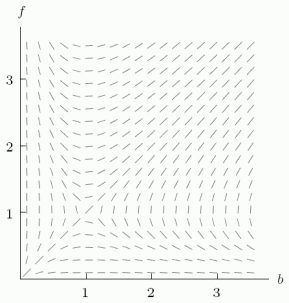Multiple Choice
Let f be the number of fruit tree blossoms (in ten thousands) and let b be the number of bees (in hundreds) in an orchard. Suppose f and b satisfy the differential equations  and
and  , which correspond to the slope field in the figure. Assume f = 3 and b = 3 when t = 0. What happens to the number of fruit tree blossoms and bees over time?
, which correspond to the slope field in the figure. Assume f = 3 and b = 3 when t = 0. What happens to the number of fruit tree blossoms and bees over time? 
A) The solution approaches the origin.
B) The solution approaches the line f = b.
C)  , but b does not.
, but b does not.
D)  , but f does not.
, but f does not.
Correct Answer:

Verified
Correct Answer:
Verified
Q89: Which of the following differential equations goes
Q90: Money in a bank account grows continuously
Q91: Two minor league baseball teams in the
Q92: Consider three strains of the flu modeled
Q93: Which one(s) of the following are solutions
Q95: At time t = 0, there are
Q96: In a study of the milk drinking
Q97: What is the solution of <img src="https://d2lvgg3v3hfg70.cloudfront.net/TB8190/.jpg"
Q98: Bees and flowers help each other, and
Q99: For a new strain of the flu,